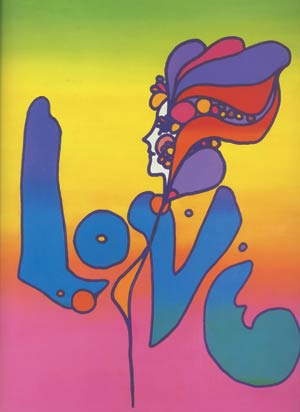[av_slideshow_full size=’no scaling’ stretch=” animation=’fade’ autoplay=’false’ interval=’5′ control_layout=’av-control-default’ src=” attachment=” attachment_size=” position=’top left’ repeat=’no-repeat’ attach=’scroll’]
[av_slide_full slide_type=’image’ id=’60705′ video=” mobile_image=” video_format=” video_ratio=” title=’Peter Max’ custom_title_size=’48’ custom_content_size=’20’ caption_pos=’caption_center’ link_apply=” link=’lightbox’ link_target=” button_label=” button_color=’light’ link1=’manually,http://’ link_target1=” button_label2=” button_color2=’light’ link2=’manually,http://’ link_target2=” font_color=’custom’ custom_title=’#ffffff’ custom_content=’#020202′ overlay_enable=’aviaTBaviaTBoverlay_enable’ overlay_opacity=’0.1′ overlay_color=’#444444′ overlay_pattern=” overlay_custom_pattern=”]
BY KARLA KLEIN ALBERTSON
[/av_slide_full]
[/av_slideshow_full]
[av_textblock size=” font_color=’custom’ color=’#ffffff’]
Detail of Peter Max, Sailing New Worlds, 1976, Lithograph; image courtesy The Art of Peter Max, Abrams, New York.
[/av_textblock]
[av_section min_height=” min_height_px=’500px’ padding=’default’ shadow=’no-border-styling’ bottom_border=’no-border-styling’ id=” color=’main_color’ custom_bg=’#f2f2f2′ src=” attachment=” attachment_size=” attach=’scroll’ position=’top left’ repeat=’no-repeat’ video=” video_ratio=’16:9′ overlay_opacity=’0.5′ overlay_color=” overlay_pattern=” overlay_custom_pattern=”]
[av_one_full first min_height=” vertical_alignment=’av-align-top’ space=” margin=’0px’ margin_sync=’true’ padding=’10px,20px,10px,20px’ border=’1′ border_color=’#eaeaea’ radius=’0px’ radius_sync=’true’ background_color=’#ffffff’ src=” attachment=” attachment_size=” background_position=’top left’ background_repeat=’no-repeat’]
[av_hr class=’invisible’ height=’30’ shadow=’no-shadow’ position=’center’ custom_border=’av-border-thin’ custom_width=’50px’ custom_border_color=” custom_margin_top=’30px’ custom_margin_bottom=’30px’ icon_select=’yes’ custom_icon_color=” icon=’ue808′ font=’entypo-fontello’]
[av_textblock size=” font_color=” color=”]
Over his life, Peter Max has used his art to create a transcendent world on the other side of reality.
[/av_textblock]
[av_hr class=’invisible’ height=’30’ shadow=’no-shadow’ position=’center’ custom_border=’av-border-thin’ custom_width=’50px’ custom_border_color=” custom_margin_top=’30px’ custom_margin_bottom=’30px’ icon_select=’yes’ custom_icon_color=” icon=’ue808′ font=’entypo-fontello’]
[av_textblock size=’16’ font_color=’custom’ color=’#686868′]
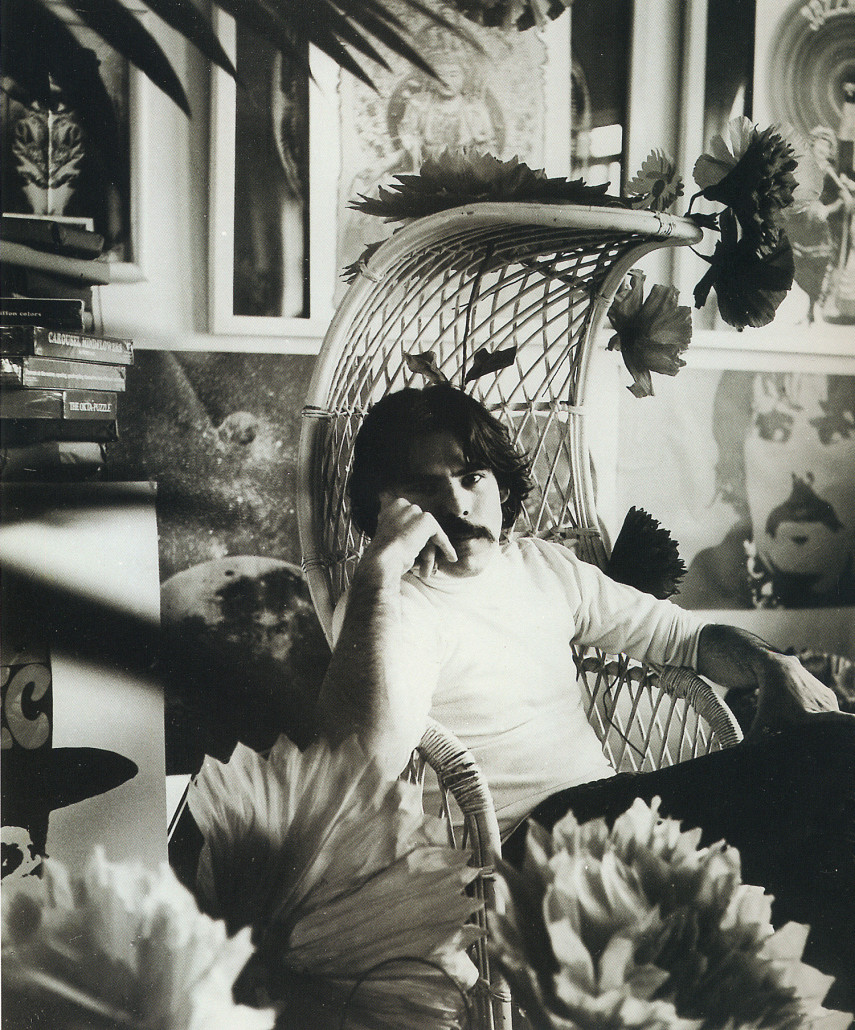
From the cosmic imagery that first brought him to national attention in the 1960s to his more abstract “neo-Fauvist” paintings of today, his work is filled with dynamic color and buoyant expectation. More than just feel-good vibes, his art lifts the spirit to a plane above the everyday.
Max’s art is rooted in a variety of influences that began with an unconventional childhood. Born in Berlin in 1937, he traveled shortly thereafter with his parents to pre-Maoist Shanghai, where he spent the first 10 years of his life. In a June interview, the artist recalled, “We lived in a pagoda house, and across the street was a Sikh temple. Living in the Orient put me in touch visually with lots of colors – red and gold everywhere.”
A slightly older child who babysat for the family supplied art materials to amuse the young boy. Max said, “Every day she pulled out sheets of paper; I started drawing and painting with brushes. I fell in love with the juxtaposition of certain colors. I learned how to combine and pair them. But I never thought that art was something you do when you grow up. You ride a bicycle but you don’t become a professional bike rider.”
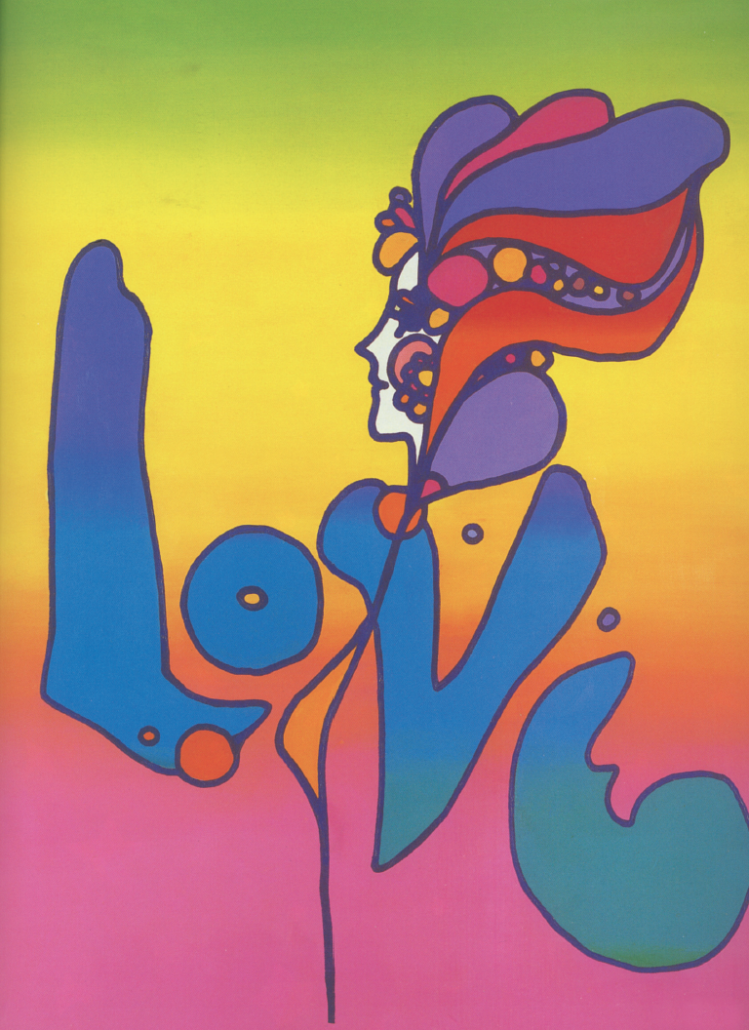
A chance trip with his parents to a region near Tibet brought him closer to the stars, both physically and spiritually. “I’m now living on top of this huge mountain and painting and drawing there,” explained Max. “Another guest in the hotel – an old white-haired man – said he was making an antenna for his radio. He was an astronomer.”
“We talked about the planets, the stars, the universe every day. Years later, it’s still an enormous passion of mine. When I got older, I wanted to become an astronomer.” Twenty years after those conversations, the artist would combine his love of color and fascination with the cosmos into successful graphics that secured his reputation.
After an odyssey of travel – Africa, Italy, Israel, France – the family arrived in New York in 1953, where Max still considered becoming an astronomer because as he put it, “I wanted to know everything about the universe. Why was the universe created, how did the Big Bang happen, how far is really far?”
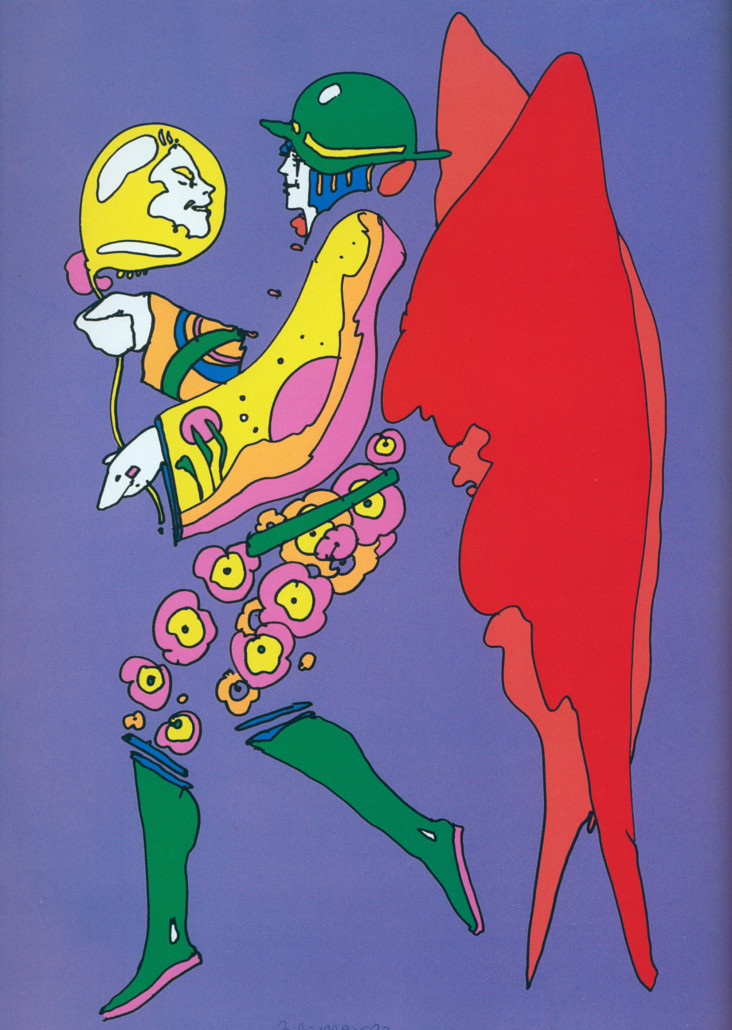
His career took a different direction when a summer session at the Art Students League led to years of intense study at the institution. His early focus was grounded in reality rather than fantasy. He said, “I just wanted to become the best realist that ever was. I was going to be an artist, but I didn’t even know how I was going to make a living. But I was good at it and I loved doing it.”
The Art of Peter Max (Abrams 2002), with text by CUNY professor Charles A. Riley II, includes several pictures from the artist’s realist period. Life Study of Old Man and Cowboy, both muted oil paintings from 1959, demonstrate what an excellent realist Max could be in his early twenties. But the young artist found that – with the dominance of photography – art directors were not buying his realism.
During an interview, one potential buyer spotted some “astronomical doodles of the planets” that had ended up with more serious work in Max’s portfolio. Interest in the artist’s more casual alternative work led to a proliferation of projects that drew Max into the pop poster business. The mature style – romantic, playful, and often psychedelic – that Max had fully developed by around 1966 was perfectly in sync with the spirit of the times. To quote him, “Everybody thought these posters were the backdrop of the Sixties.”
Author Charles Riley in his biographical text to The Art of Peter Max wrote:
“Max understood that art reproductions were rising to the status of the original artwork and began to incorporate this notion into his art. The medium of the moment was the poster, owing in no small part to the work of Max himself. He became a pioneer in the printing techniques by which inexpensive yet high-quality posters could be produced in an unprecedented range and intensity of colors, utilizing state-of-the art commercial presses that expanded the spectrum of available hues.”
Riley concluded, “Just as Toulouse-Lautrec captured the imagination of late 19-century Paris with his posters, Max led the international youth movement of the Sixties into a new visual culture.” Classic images that nurtured the Baby Boom Generation include Max’s 1967 Bob Dylan poster, the singer’s photographic image surrounded by a floral aura; the single word Love with a flowing head above from 1968, and the 1968 image of A Different Drummer, surrounded by stars.
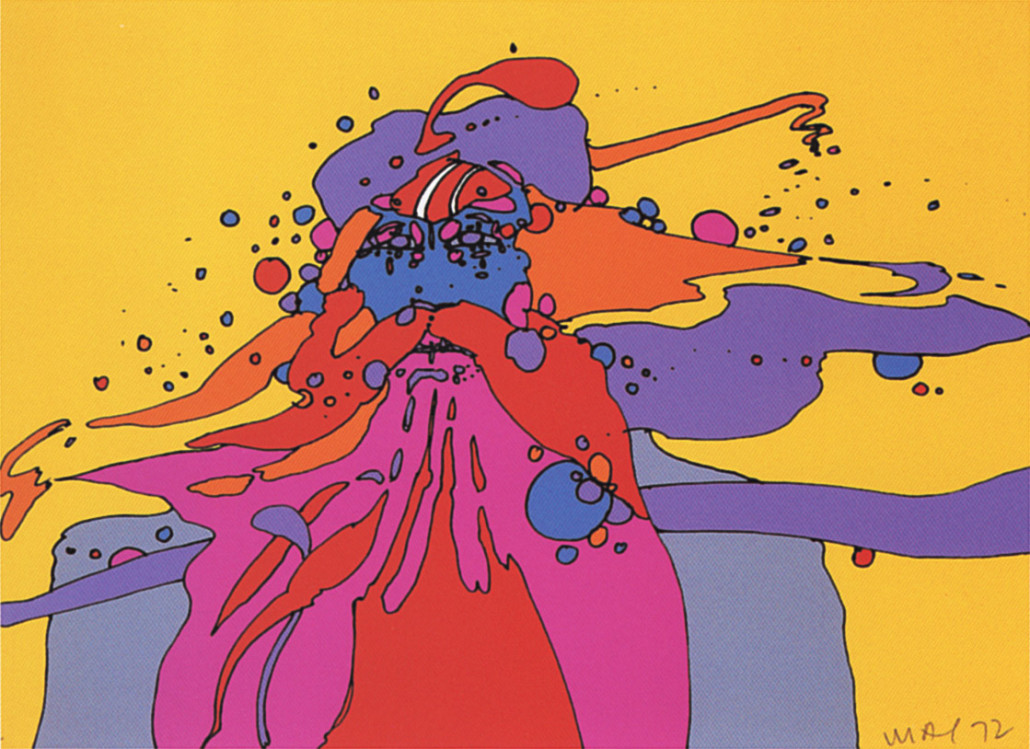
Commercial success brought the genial Peter Max fame in a Johnny Carson/Life magazine sense. An association with Swami Satchidananda, which began in 1966, brought the artist greater inner peace and led to some sublime images of that state, such as the 1971 serigraphs Experiencing Nothing and Knowledge Bliss Absolute.
Max can tell some great stories. One of the best involves an encounter with Jimi Hendrix that occurred when Max was renting a house in Woodstock to give his family some time away from the city. Max said, “One morning my little daughter was wearing a blue jean jacket, the waist dragging on the floor, because she was tiny. Suddenly somebody knocks on the door and it was Jimi Hendrix.”
The jacket, of course, turned out to be one that Hendrix had left on a previous visit – he let the artist’s daughter keep her treasure. And Max recalled, “He hung around for a hour talking. I told him about art; he told me about music. He was a sweet guy, a nice guy with lots of enthusiasm.”
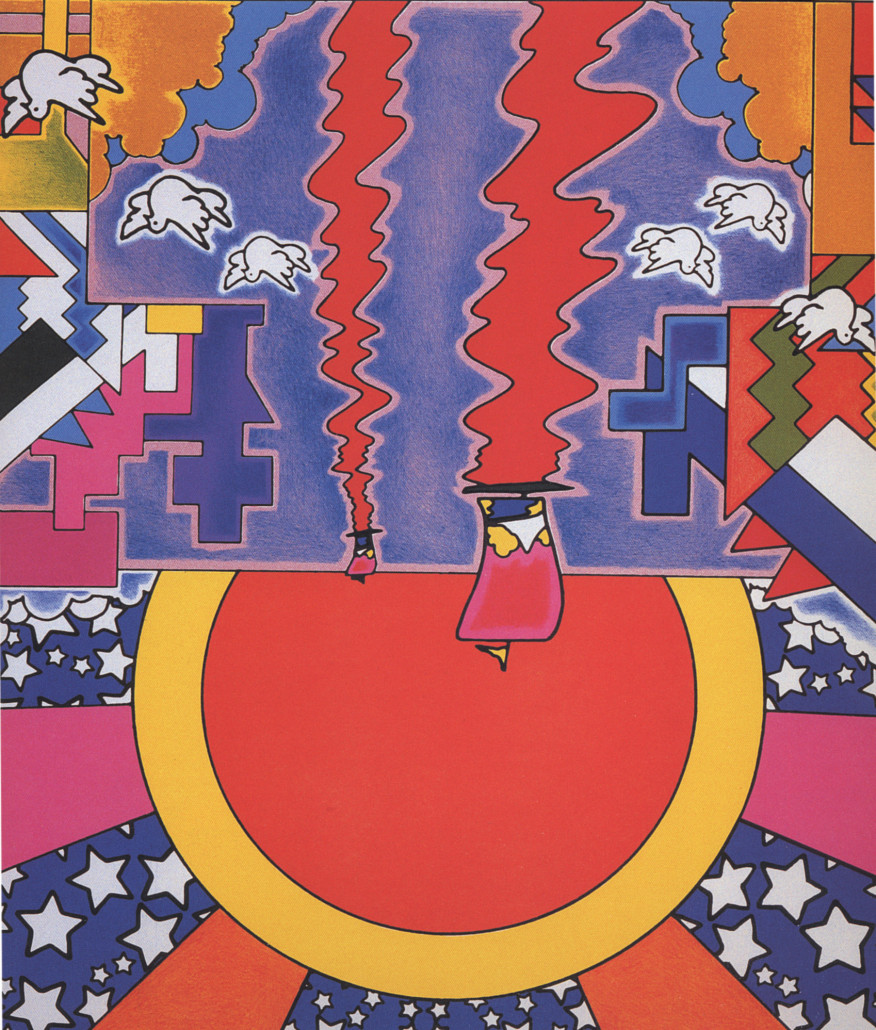
courtesy The Art of Peter Max, Abrams, New York.
Peter Max’s bold early works from the 1960s and ’70s remain popular with collectors, who are in a very real sense buying back part of their youth. Robert Rogal, Director of the Ro Gallery in Long Island City, N.Y., and a Boomer himself, told Style Century Magazine, “We’ve been handling his work for the last 30 years. I think the older work is more important and more popular than the current work. It’s probably a moment in time – that’s why I prefer the vintage work. It’s not only true with him; it’s true with all artists. Even with recording artists, you always remember their first song.”
[/av_textblock]
[av_hr class=’invisible’ height=’50’ shadow=’no-shadow’ position=’center’ custom_border=’av-border-thin’ custom_width=’50px’ custom_border_color=” custom_margin_top=’30px’ custom_margin_bottom=’30px’ icon_select=’yes’ custom_icon_color=” icon=’ue808′ font=’entypo-fontello’]
[av_heading heading='”Living in the Orient put me in touch visually with lots of colors – red and gold everywhere.”‘ tag=’h3′ style=’blockquote classic-quote’ size=’44’ subheading_active=” subheading_size=’10’ padding=’5′ color=’custom-color-heading’ custom_font=’#050505′]
there was an enormous change happening to us here in this country, and it felt like it was the whole planet. It’s still going on.”’ tag=’h3′ style=’blockquote classic-quote’ size=’44’ subheading_active=” subheading_size=’10’ padding=’5′ color=’custom-color-heading’ custom_font=’#050505′]
there was an enormous change happening to us here in this country, and it felt like it was the whole planet. It’s still going on.”’ tag=’h3′ style=’blockquote classic-quote’ size=’44’ subheading_active=” subheading_size=’10’ padding=’5′ color=’custom-color-heading’ custom_font=’#020202′]
there was an enormous change happening to us here in this country, and it felt like it was the whole planet. It’s still going on.”’ tag=’h3′ style=’blockquote classic-quote’ size=’44’ subheading_active=” subheading_size=’15’ padding=’10’ color=’custom-color-heading’ custom_font=’#020202′]
[/av_heading]
[av_hr class=’invisible’ height=’50’ shadow=’no-shadow’ position=’center’ custom_border=’av-border-thin’ custom_width=’50px’ custom_border_color=” custom_margin_top=’30px’ custom_margin_bottom=’30px’ icon_select=’yes’ custom_icon_color=” icon=’ue808′ font=’entypo-fontello’]
[av_textblock size=’16’ font_color=’custom’ color=’#686868′]
Since first achieving recognition, Peter Max has never lost touch with his creativity. On the one hand, he has expressed an inner artistic vision through a long series of vibrant abstract acrylics that are just as colorful as his early work. Riley explained in his text, “Max calls himself a neo-Fauvist, identifying himself with the French painters of the turn of the 20th century who were called fauves (wild beasts) for their dramatic use of color.”

On the other, Max continues to produce art connected with pop culture phenomena and posters for projects dear to his heart, such as global ecology, equal rights, animal protection, and peace. His ongoing interest in space led to a series of images commemorating the Apollo moon landings. His “Preserve the Environment” postage stamp of 1974 anticipated today’s concern for global climate conditions.
In 1986, Max began a continuing series of studies of the Statue of Liberty, with a special set of six in 2001 to benefit 9/11 organizations. He has designed images for musical events from Woodstock to the Grammys. And he has found time to work with a long list of American Presidents and world leaders on positive initiatives that support the values that took root in his consciousness back in the Sixties.
At the conclusion of the interview, Peter Max said, “It was nice to belong to something so colossal. There was an enormous change happening to us here in this country, and it felt like it was the whole planet. It’s still going on.”
More of Max’s biography and an online shop of vintage and new works can be found at www.petermax.com.
[/av_textblock]
[/av_one_full][/av_section][av_one_full first min_height=” vertical_alignment=’av-align-top’ space=” margin=’0px’ margin_sync=’true’ padding=’80px,40px,80px,40px’ border=’1′ border_color=’#eaeaea’ radius=’0px’ radius_sync=’true’ background_color=’#ffffff’ src=” attachment=” attachment_size=” background_position=’top left’ background_repeat=’no-repeat’]
[av_textblock size=” font_color=” color=”]
 About Karla Klein Albertson
About Karla Klein Albertson
Karla Klein Albertson focuses on the decorative arts, from excavated antiquities to contemporary pop-culture icons. She currently writes the Ceramics Collector column and exhibition features for Auction Central News, covers shows and auctions for the Maine Antique Digest, and authors the Antiques column in The Philadelphia Inquirer. She holds a master’s degree in classical archaeology from Bryn Mawr College.
[/av_textblock]
[/av_one_full]
[av_hr class=’invisible’ height=’50’ shadow=’no-shadow’ position=’center’ custom_border=’av-border-thin’ custom_width=’50px’ custom_border_color=” custom_margin_top=’30px’ custom_margin_bottom=’30px’ icon_select=’yes’ custom_icon_color=” icon=’ue808′ font=’entypo-fontello’]
[av_one_fifth first min_height=” vertical_alignment=” space=” custom_margin=” margin=’0px’ padding=’0px’ border=” border_color=” radius=’0px’ background_color=” src=” background_position=’top left’ background_repeat=’no-repeat’][/av_one_fifth]
[av_four_fifth min_height=” vertical_alignment=” space=” custom_margin=” margin=’0px’ padding=’0px’ border=” border_color=” radius=’0px’ background_color=” src=” background_position=’top left’ background_repeat=’no-repeat’]
[av_sidebar widget_area=’SCM – 728×90 – footer’]
[/av_four_fifth]
[av_slideshow_full size=’no scaling’ stretch=” animation=’fade’ autoplay=’false’ interval=’5′ control_layout=’av-control-default’ src=” attachment=” attachment_size=” position=’top left’ repeat=’no-repeat’ attach=’scroll’]
[av_slide_full slide_type=’image’ id=’60710′ video=” mobile_image=” video_format=” video_ratio=” title=” custom_title_size=” custom_content_size=” caption_pos=’caption_bottom caption_bottom_framed caption_framed’ link_apply=” link=’lightbox’ link_target=” button_label=” button_color=’light’ link1=’manually,http://’ link_target1=” button_label2=” button_color2=’light’ link2=’manually,http://’ link_target2=” font_color=” custom_title=” custom_content=” overlay_opacity=’0.1′ overlay_color=” overlay_pattern=” overlay_custom_pattern=”]
Peter Max, Profile, 1996, acrylic on canvas; image courtesy The Art of Peter Max, Abrams, New York.
[/av_slide_full]
[/av_slideshow_full]


